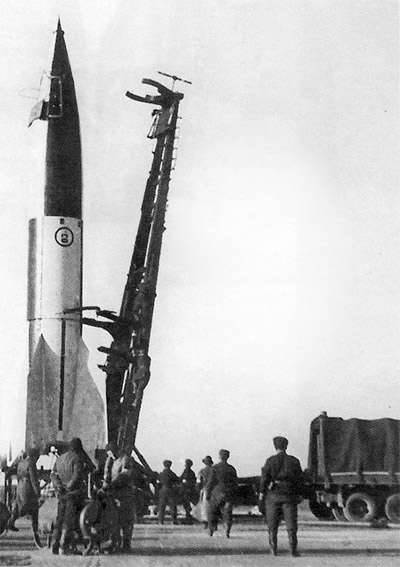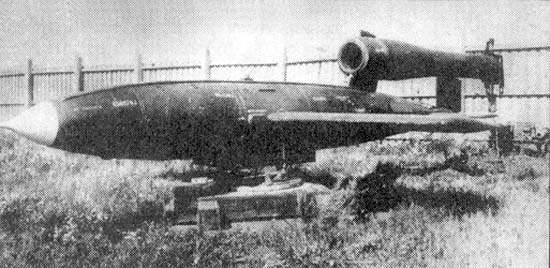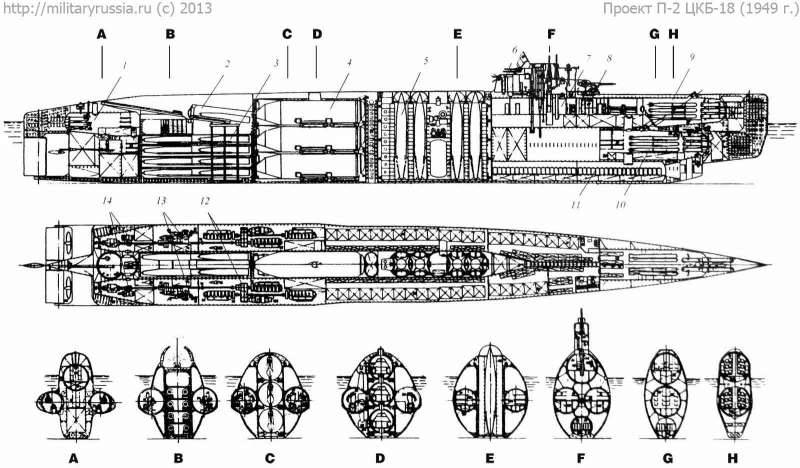The project of a submarine with missile armament P-2
By the end of the forties, the military expressed a desire to receive promising diesel-electric submarines with missile weapons in the future. It was proposed to install projectiles and ballistic missiles on submarines. Such weapons made it possible to solve a wide range of combat missions involving an attack on surface and coastal targets. By this time, Soviet specialists had achieved certain successes in the field of missile weapons of new classes, which made it possible to consider the possibility of using such systems not only in the ground forces and aviation, but also on ships or submarines of the fleet.
Project P-2
In 1949, discussions on promising topics moved into the development stage of the first projects. The Ministry of Shipbuilding Industry commissioned TsKB-18 (now the Central Design Bureau for Marine Equipment Rubin) to work out the possibility of creating a promising diesel-electric submarine with missiles. The head of these works was appointed F.A. Kaverin. It is noteworthy that the required pre-sketch design had to take into account the equipment of the submarine with both ballistic missiles and projectiles. In addition, it was proposed to equip the submarine and some other special equipment. Later, several options were offered for submarine armament with similar systems in various combinations. In fact, a submarine design with modular weapons was developed.
The project of a submarine with missile weapons received the designation П-2. It was proposed to include the 10X and the Swallow cruise missiles, as well as the P-1 ballistic missiles, into the nomenclature of weapons of various versions of the submarine. All such products have already passed part of the tests and could be considered as weapons for the new fleet equipment. In addition, the submarine had to carry 12 bow and 4 stern torpedo tubes with ammunition to 30 torpedoes. Some versions of the project also provided for equipping the boat with a compartment for transporting ultra-small underwater vehicles. In the surface position, the submarine could use twin installations with 57-mm and 25-mm artillery pieces.
The rocket armament complexes were to be carried out in the form of units of similar size and shape with a different composition of equipment. They should be placed in the gap between the two fodder solid hulls. In this position, the module occupied all the space from the deck to the bottom of the light hull and contained all the necessary weapon. The size of the submarine P-3 allowed to mount and use up to three modules for various purposes.
The P-2 project proposed the construction of a diesel-electric substation with a length of about 110-120 m, a maximum width of 12,5 m and a draft of less than 10 m with a normal displacement of 5360 t. general light body. The combined architecture of the main power plant, which was required to develop the power of 15 ths. Hp, was considered. It was proposed to use six diesel engines with an 2000 horsepower, two steam and gas turbine units with a capacity of 7500 hp, as well as two electric motors of a suitable type for an economical underwater stroke.
According to calculations, the diesel engine while driving on the surface position allowed it to reach speeds up to 18 knots. With the steam and gas turbine installation, the underwater speed reached 17 nodes, while using electric motors - an 4 node. The maximum cruising range was determined at the level of 12 thousand nautical miles. The steam and gas turbine unit allowed us to go under water up to 700 miles with maximum speed, the electric motor - 100 miles. The strength of the hulls was to provide immersion to depths up to 200 m
Ballistic missiles
In the central part of the submarine, behind the felling fence or closer to the aft, there was a compartment to accommodate ballistic missiles of the required length. The module for ballistic missiles was to be carried out in the form of a large block with a solid hull installed in the corresponding part of the submarine. Four launchers were to be placed inside this module, as well as a set of special equipment. For use by the P-2 submarine, missiles of the P-1 type were considered, which imposed significant restrictions on the design of the carrier and its systems.
Recall, the P-1 rocket was a copied version of the German product A-4, the development of this project was carried out by the Scientific Research Institute-88 under the guidance of S.P. Queen. The first missiles of this type were made of captured German components, and later the production of own products of the necessary types was launched. Until the end of the forties, the P-1 rocket passed all the necessary tests, after which it was put into service for special-purpose rocket brigades. The operation of this weapon continued until the mid-fifties, after which it was replaced by newer systems.

Preparations for the launch of the rocket P-1
The design of the P-1 rocket was based on the German project A-4, but it had some differences. Due to the use of other technologies and materials, it was decided to recycle a part of the product design. This led to the development of new tail and instrument compartments, as well as to the change of some structural elements in view of the use of materials produced in the Soviet Union.
The P-1 rocket was equipped with a large extension casing, inside which all the necessary units were located. The separation of the product in flight was not provided, the warhead was not separated. Most of the body was given under the tanks for ethanol and liquid oxygen. In the tail of the rocket was placed liquid engine RD-100. The engine running time was 65, the thrust depended on the series. After the start of mass production, it was possible to increase the thrust from 25 to 26-27.
To control the rocket, an inertial system based on gyroscopes and a temporary mechanism was used. The task of the gyroscopic instruments was to control the tail rudders and hold the rocket on the desired trajectory of the active part of the flight. At a pre-calculated time entered into the memory of the equipment, the automation had to shut off the engine and transfer the rocket into an uncontrolled flight along a ballistic trajectory that lasted until the moment of hitting the target.
The total length of the P-1 production rocket was 14,275 m, the case diameter was 1652 mm, the span of the stabilizer was 3,56 m. The starting mass reached 13,43 t, of which 9,4 t was accounted for fuel and oxidizer. The high-explosive warhead with a total weight of 1075 kg carried an 785 kg of explosive. The rocket could fly to a distance of 270 km. When flying at maximum range, the trajectory reached an altitude of 77 km. CWE was determined at the level of 1500 m.
The module for ballistic missiles was equipped with four retractable launchers, on which the missiles were to be secured before the submarine went out to sea. Before launching the rocket, the submarine had to rise to the surface and take the rocket up to the starting position. For such a launcher required a new launch pad with a stabilization system. Special mechanisms were required to compensate for the roll and maintain the position of the starting table for 7-10 with after the start command. The launching table was supposed to stabilize before the rocket engine exited the nominal mode and before it was raised.
An unusual solution was required by the task of fueling rockets. Relatively stable ethyl alcohol could be poured into the tanks of all four missiles even in preparation for going to sea. Liquid oxygen, however, was required to be stored separately from the rocket. For its transportation, a special insulated tank and corresponding pipelines were included in the rocket module. A liquefaction plant was also included in the oxygen system, the task of which was to return the evaporating oxygen to the required liquid state. To fill the oxygen tanks of the missiles should be only in preparation for launch.
One module for the P-1 missiles contained four launching pads with weapons. Thus, with the use of the maximum possible three modules of the diesel-electric submarines of the P-2 project, it could carry up to 12 ballistic missiles and attack coastal targets at ranges up to 270 km. The possibility of simultaneously equipping the submarine with ballistic and cruise missiles, as it was supposed, should have expanded the range of combat missions to be solved.
Aircraft Shells
An alternative weapon of the P-2 type submarine was supposed to be the Swallow cruise missiles. This weapon was created by the team of V.N. Chelomey on the basis of the product 10Х / 10ХН, which was, in turn, the result of the development of the groundwork and design of the German projectile Fi-103. In the late forties, several modifications of the 10X rocket were proposed for aviation, ground forces and, finally, for the fleet. They had the highest possible degree of unification, but differed by one or other design features.
For the use of the Swallow missile on the P-2 submarine, a special module was developed. Inside the robust hull, in its lower part, was placed mechanized laying for transporting missiles and their subsequent submission to the launcher. The missiles should be transported in a tucked-in form, with undocked wings and stabilizers. In the upper part of the module, reaching the level of the deck of the submarine, there was a beam launcher for firing at the stern.

10X Projectile
By design, the Swallow rocket, like other products from the 10X family, was similar to the basic development of German industry. She had an elongated sleek fuselage and a straight wing. Above the tail end of the projectile was a pulsating air-jet engine D-3 or D-5. The rocket had a length of 7,5 m and a wingspan of 6,5 m. Starting weight reached 3,5 t, the flight was about a ton less. The rocket could be equipped with an autopilot based on the inertial navigation system or the means of radio command control. The product could reach speeds of up to 600 km / h and fly to a distance of 240 km. A high-explosive warhead weighing 1 t was delivered to the target.
To launch from a submarine rocket "Swallow" had to use two launch accelerator. Moreover, only one of them was attached directly to the rocket. The second was proposed to leave on one of the elements of the launcher. The joint work of the two accelerators had to lift the rocket into the air and accelerate it to the speed ensuring the work of the cruise engine.
The launcher of the submarine module P-2 consisted of a rail and a mobile truck with mounts for a rocket. Before shooting, the submarine had to rise to the surface and begin preparations for launch. A rocket was removed from the cellar, which should have been mounted on a launcher carriage and equipped with planes. In addition, at this stage it was planned to suspend two accelerators. Immediately before firing, the guide with a length of 20 m should have risen at an angle of 8-12 °. In this case, the work should have been included stabilizer, compensating rolling.
The initial acceleration was to be carried out with a solid-fuel accelerator RBT-70 mounted on a trolley. Having passed 20 m, the cart had to drop the rocket. After that, the “Swallow” had to continue flying with the help of its own accelerator of the same model, and then turn on the cruising engine and head for the target.
In one module for projectiles, it would be possible to transport up to 16 missiles. In the version of the submarine P-2, equipped only with cruise missiles, the total ammunition would consist of the 51 product "Swallow". Such a weapon would allow the submarine to hit coastal targets from a distance of 240 km.
Results of the project
The pre-draft version of the P-2 project diesel-electric submarines, which included the use of cruise and ballistic missiles, was developed in 1949. Further, representatives of the fleet and industry who made their decision familiarized themselves with this project. A promising modular submarine project was considered too complicated and unsuitable for immediate implementation. Thus, in view of the impossibility of the full implementation of all plans, it was decided to abandon the further development of the new submarine. By the end of 1949, TsKB-18 and related organizations have stopped developing the P-2 project. The released efforts were devoted to the development of other projects, not so bold, but much more realistic.
According to the available data, by the time the P-2 project was stopped, some success was achieved, but a number of the most important elements were not created. In particular, the work on the stabilized launch pad for the P-1 rocket was not completed. It was also expected problems with the creation of oxygen equipment for the module of ballistic missiles. As for weapons, in general, with the P-1 and Swallow missiles, in general, there was no particular difficulty. These systems could in theory be adapted for a new carrier.
Serial construction of submarines of the type P-2 allowed to significantly increase the striking power of the submarine forces of the Navy. They were able to produce not only torpedo attacks from ships and ships, but also to fire on coastal targets at some distance from the coast. All this could significantly increase the combat capability of the submarine forces, as well as give them some new tactical roles.
However, the P-2 project was considered too complicated. A submarine of modular design with the ability to carry airplanes and ballistic missiles attracted a potential customer, but its development and construction were associated with a host of problems of various kinds. In addition, by the time of the proposed completion of the existing missiles could be outdated. As a result, a promising project had to be abandoned in favor of more realistic designs.
Despite the closure of the project P-2, the development of submarine weapons continued. The following work in this direction led to the fact that at the end of the fifties the cruise missile P-5 and the ballistic P-11FM entered service. The carriers of this weapon did not differ in their boldness of design, like the P-2, but they could fully solve the assigned combat tasks and attack various targets in a wide range of ranges.
Based on:
http://deepstorm.ru/
http://airwar.ru/
http://militaryrussia.ru/blog/topic-711.html
Shirokorad A.B. Weapons of the domestic fleet. 1945-2000. - Minsk: “Harvest”, 2001
- Ryabov Kirill
- Militaryrussia.ru, Airwar.ru

Information